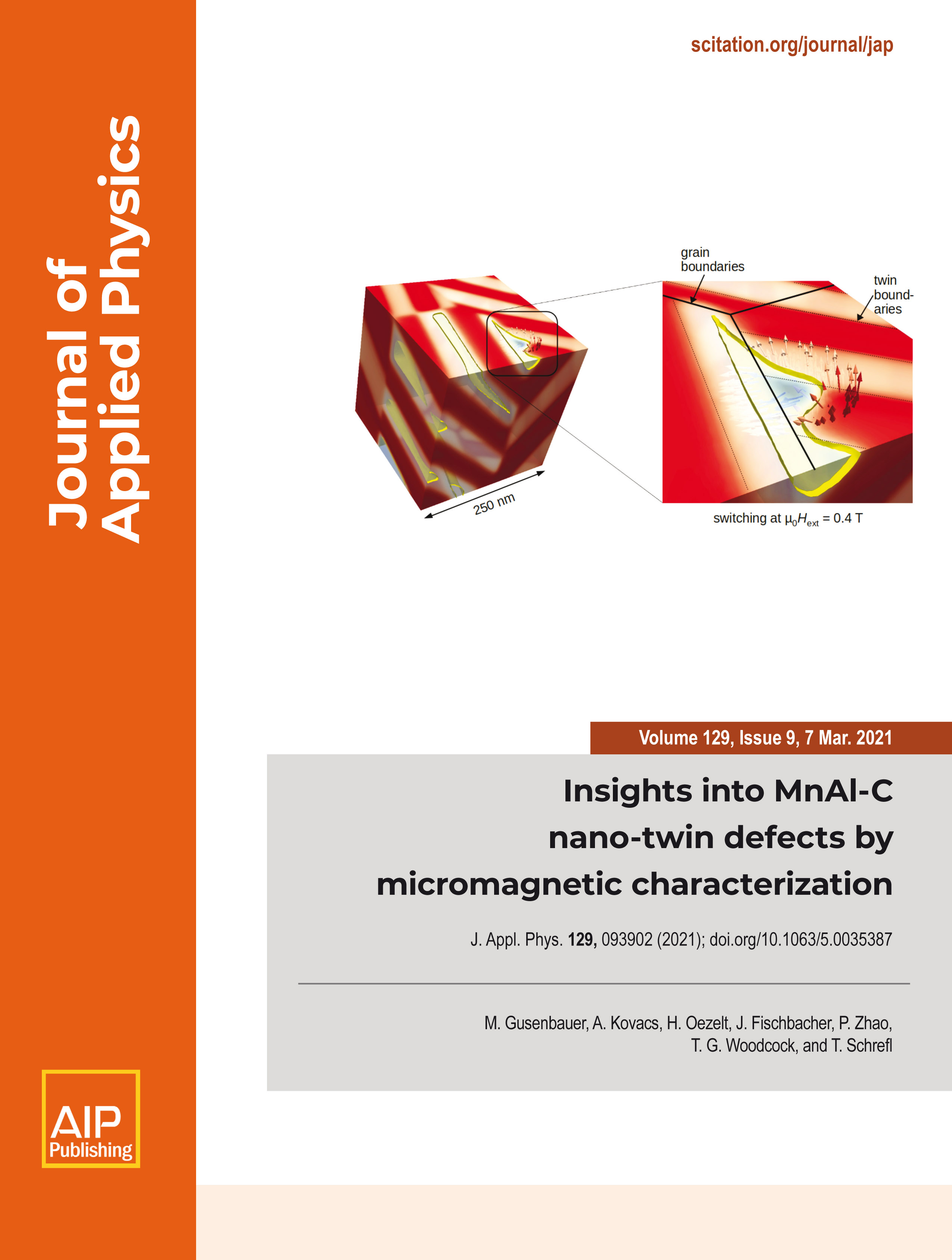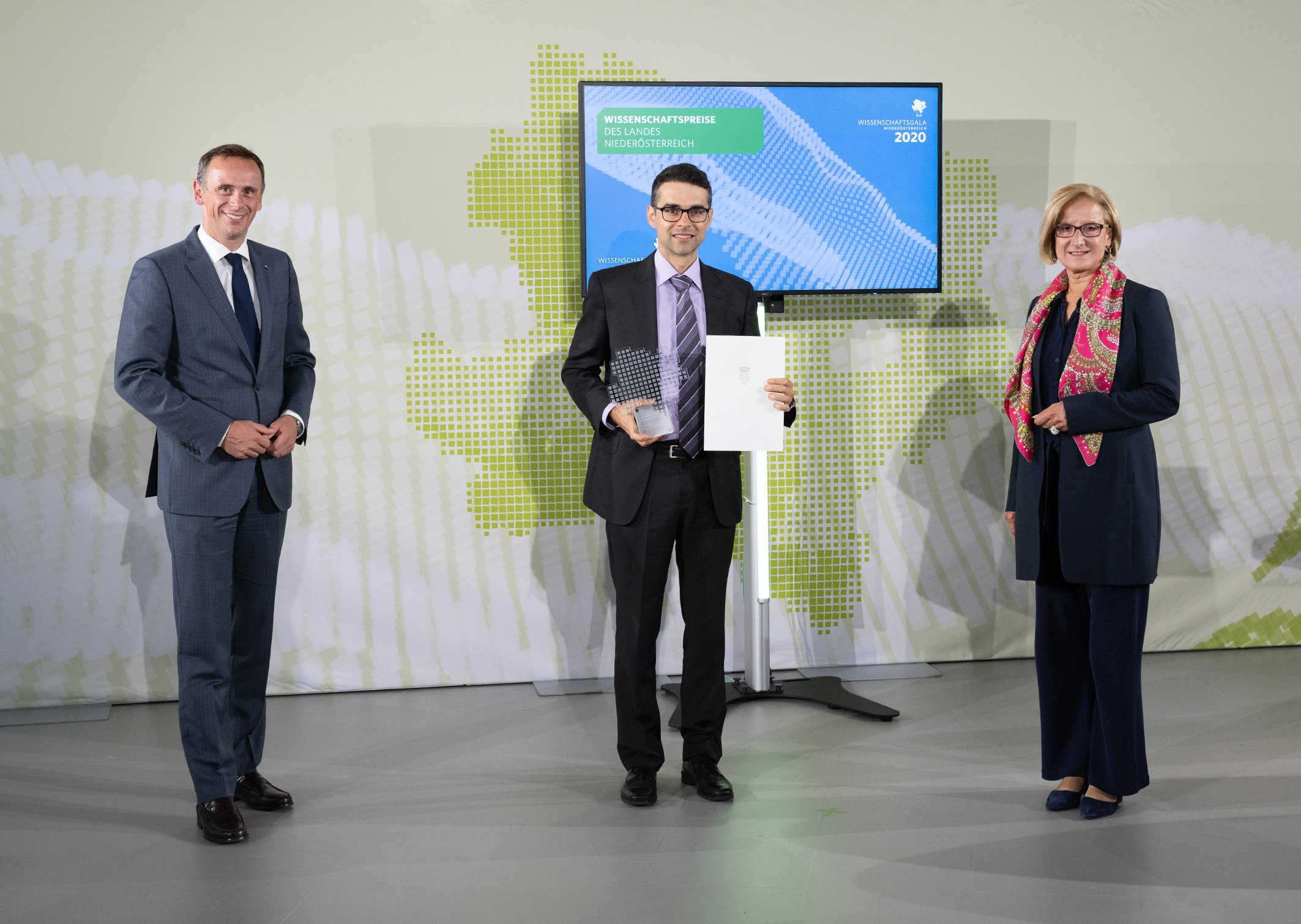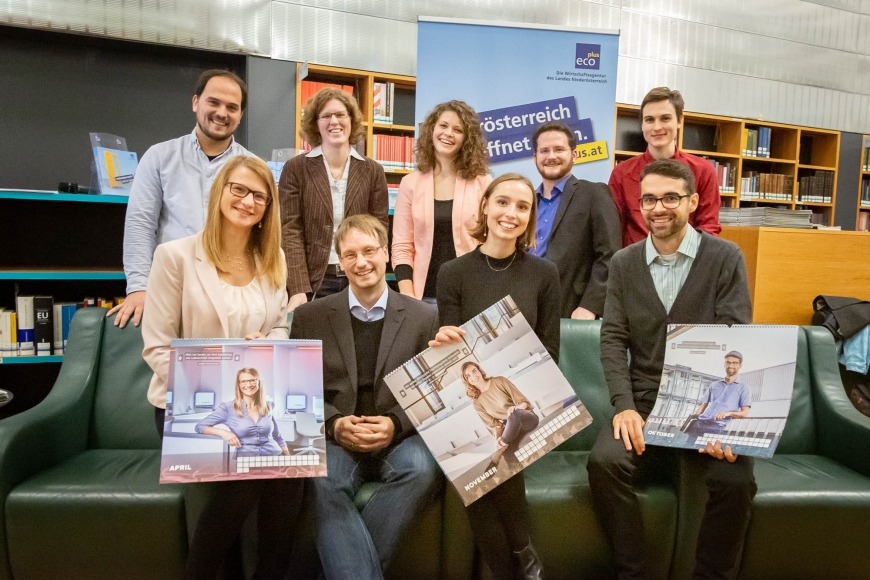Dauermagnete sind ein wichtiger Baustein unserer modernen Gesellschaft. Anwendungsgebiete umfassen den umweltfreundlichen Verkehr, Wasser- und Windkraft. Ein vielversprechendes magnetisches Material ist MnAl-C. Obwohl es keine ferromagnetischen Elemente wie Eisen, Nickel oder Kobalt enthält, ist die sogenannte tau Phase auch bei hohen Temperaturen ferromagnetisch und zeigt all jene Eigenschaften, die Voraussetzungen für einen hochleistungsfähigen Permanentmagnet sind. Tau-MnAl-C enthält keine kritischen Elemente, weshalb ihre längerfristige Anwendung umweltfreundlich ist - in starkem Gegensatz zu seltenerdhaltigen Magneten wie z.B. Nd-Fe-B. Des Weiteren hat tau-MnAl-C eine niedrige Dichte, die für Anwendungen in Transport und Luftfahrt von Vorteil ist.
In diesem Projekt wird ein neuartiger Ansatz benutzt, der hochmoderne Charakterisierung mit hochmoderner Computersimulation kombiniert, um quantitative Aussagen zum Einfluss von Grenzflächen auf Ummagnetisierungsprozesse in tau-MnAl-C zu erhalten.
Aktuell
Wir haben die Arbeit: "Insights into MnAl-C nano twin defects by micromagnetic characterization" im Journal of Applied Physics veröffentlicht. Die Publikation wurde sowohl auf dem Cover abgebildet als auch vom Herausgeber, dem AIP, für eine besondere Form eines Wissenschaftshighlights, dem sogenannten Scilight, ausgewählt:
Larter, Raima. “Crystallographic defects strongly influence alloy’s magnetic properties”. AIP Scilight. 2021. DOI: 10.1063/10.0003702

Markus Gusenbauer wurde mit dem Anerkennungspreis des Landes Niederösterreich für besondere wissenschaftliche Leistungen ausgezeichnet (https://www.noe.gv.at/noe/Wissenschaft-Forschung/wissenschaftspreise_noe.html, zuletzt besucht: 2021-03-04). Als Ergebnis wurden mehrere Presseartikel und ein Folgeartikel im Chemiereport (https://www.chemiereport.at/epaper/201907/#64, zuletzt besucht: 2021-03-04) veröffentlicht
_NLK%20Pfeiffer.2021-03-09-11-13-05.jpg)
07.07.2020: Die Forschungsergebnisse über das extrahieren von lokalen Nukleationsfeldern in Permanentmagneten mittels maschinellem Lernen konnte im Nature Partner Journal Computational Materials veröffentlicht werden (https://doi.org/10.1038/s41524-020-00361-z). Außerdem wurden die erfolgreiche Projektarbeit mit einem eingeladenen Vortrag auf dem Kongress: International Workshop on Rare-Earth and Future Permanent Magnets and their Applications (REPM2020, https://sites.udel.edu/repm2020/) in Baltimore honoriert.
Lokale Nukleationsfelder: (a) wahres Ergebnis, (b) Vorhersage, (c) absolute Abweichung
Ein Beitrag wurde eingereicht für die Konferenz: Magnetism and Magnetic Materials (MMM2020, https://magnetism.org/), die von 2. bis 6. November 2020, ursprünglich geplant in Florida, in virtueller Form stattfinden wird.
„Macromagnetic Simulations by Micromagnetic Superposition
Micromagnetic simulations are typically limited to a few micrometers due to the high demand on computing resources. But in applications and experiments the specimen size is usually orders of magnitude larger. While the micromagnetic simulations reproduce trends nicely, the absolute value of the results differ from the experiments [1]. Often the size limitation in the simulations is the reason for this deviation. Normally this is overcome either by artificial scaling [2] or by a reduced-order model [3]. In this work we introduce a type of reduced-order model to bridge the length scale from micromagnetism to experiments. In contrast to the work of Blank [4], we also consider the microstructural features of the magnet. We subdivide the computation of a large sample, e.g. from experimental measurements, into multiple independent feasible-sized subsets. For each subset, the nucleation field is either calculated by micromagnetic simulation or predicted by a trained machine learning model [5] (Fig. 1). The subsets along with their microstructure and nucleation fields are fed into a newly developed python code to spatially reassemble the entire sample and compute the overall hysteresis (Fig. 2). To take the microstructure into account, each subset is further discretized in cubic elements with their own anisotropic easy axis. In each calculation step, the magnetostatic field and the exchange field of the entire sample is calculated based on the magnetic moments of these elements. The two field contributions and an increasing external field are summed up to a total field. Taking this total field into account, we compute the reversible rotations with the Stoner-Wohlfarth model and use the prestored nucleation fields to irreversibly switch the respective subset.
We gratefully acknowledge the financial support of the Austrian Science Fund (FWF), Project: I 3288-N36 and the German Research Foundation (DFG), Project: 326646134.
References:
[1] X. Tang, et al., Acta Mater. 144, 884-895 (2018)
[2] S. Bance, et al., Acta Mater. 131, 48-56 (2017)
[3] L. Exl, et al., J. Phys. Mater. 2, 014001 (2019)
[4] R. Blank, J. Magn. Magn. Mater. 101, 1-3, 317-322 (1991)
[5] M. Gusenbauer, et al., accepted npj Comput. Mater., (2020)”
Am 12.05.2020 fand das in Krems geplante Projektmeeting auf Grund des Corona bedingten Reiseverbots online statt. Wichtige Punkte für den erfolgreichen Projektabschluss konnten erarbeitet werden. Außerdem wurde eine Publikation im Nature Partner Journal Computational Materials finalisiert. Abschließendes Thema war ein gemeinsamer Projektantrag für die Fortführung der Forschungskooperation. Wir haben uns auf ein Konzept geeinigt, welches, aufbauend von den bisherigen Erkenntnissen von MnAl-C, auch andere magnetischen Materialien untersuchen lässt.
Am 01.10.2019 fand das nächste Projektmeeting in Dresden statt. Teilnehmende Personen waren wieder Dr. Thomas G. Woodcock und Panpan Zhao vom IFW Dresden, und Dr. Markus Gusenbauer, Dr. Thomas Schrefl und Harald Özelt von der Donau-Universität Krems. Wir konnten uns ein aktuelles Bild über den genauen Status des Projekts machen. Außerdem wurden einige vielversprechende Ideen gesammelt für eine Fortführung der Zusammenarbeit nach Projektende im September 2020.
15.09.2019: Eine Projekt-Publikation mit dem Titel: “Automated meshing of electron backscatter diffraction data and application to finite element micromagnetics” wurde im Journal of Magnetism and Magnetic Materials veröffentlicht (https://doi.org/10.1016/j.jmmm.2019.165256).
Der JungforscherInnen-Kalender 2019 wurde in der Niederösterreichischen Landesbibliothek vorgestellt. Markus Gusenbauer war einer von zwölf Personen, die durch ihre überdurchschnittlichen Leistungen Niederösterreichs Technologiestandort repräsentieren.
„Es muss uns gelingen, auch weiterhin möglichst viele junge Menschen für Berufe in Wissenschaft und Forschung zu begeistern. Denn Niederösterreich braucht auch in Zukunft die schlauesten Köpfe. Die jungen Wissenschaftlerinnen und Wissenschaftler im JungforscherInnen-Kalender 2019 sind hier die besten Vorbilder. Mit ihren beeindruckenden Forschungsthemen sind sie perfekte Aushängeschilder für den niederösterreichischen Forschungsstandort“, erläuterte Wirtschafts- und Technologielandesrätin Petra Bohuslav.
jungforscherkalender_2019_web.pdf
https://www.noe.gv.at/noe/NOe_Jungforscher-Kalender_2019_praesentiert.html

Am 20.09 2018 fand ein Projektmeeting in Krems statt. Teilnehmende Personen waren Dr. Thomas G. Woodcock und Panpan Zhao vom IFW Dresden, und Dr. Markus Gusenbauer, Dr. Thomas Schrefl und Harald Özelt von der Donau-Universität Krems. Der Austausch von bisherigen Forschungsergebnissen war äußerst aufschlussreich um die nächsten Projektziele zu definieren. Es wurde ein Arbeitsplan erstellt für 3 gemeinsame Publikationen, die im nächsten Projektjahr umgesetzt werden sollen.
Ein Beitrag wurde eingereicht bei der Joint European Magnetic Symposia (JEMS) 2019 Konferenz, die vom 26. – 30. August 2019 in Uppsala stattfinden wird (http://magnetism.eu/133-jems-2019.htm).
Ein Beitrag wurde eingereicht bei der Joint European Magnetic Symposia (JEMS) 2018 Konferenz, die vom 03. – 07. September 2018 in Mainz stattfinden wird (https://jems2018.org).
„Automated micromagnetic simulations from native EBSD data
Micromagnetic simulations require a detailed knowledge of the crystallographic structure of the material. In permanent magnets with reduced or no rare-earth elements typically crystallographic features play an important role for the energy density product. In MnAl compounds twinning and antiphase boundaries are known to effect nucleation and pinning fields. Micromagnetic simulations can help to improve the understanding of these effects on the hysteresis properties.
In preliminary studies artificial microstructures have been used for the simulations. Here we take native Electron Backscatter Diffraction (EBSD) data of MnAl microstructures to automatically create high quality finite element meshes with adaptive mesh size. A fast micromagnetic solver, minimizing the Gibbs’ free energy, is applied subsequently and computes the hysteresis properties of the microscopic data.
The automated meshing and micromagnetic simulation routine is controlled via a Python script. Dream3D extracts EBSD data and converts them to a pixelated bitmap. Using image manipulation tools, the bitmap is automatically smoothed, corrected and upscaled. Iso2Mesh creates a 3D finite element mesh. An additional airbox, which is required for the stray field computation, is prepared with the Salome tool. The computed coercive fields are in the range of 0.36 T/μ0 to 0.53 T/μ0 depending on the density of defects.”
Unsere Projektpartner in Dresden haben einen Beitrag eingereicht beim Materials Science and Engineering Congress - MSE 2018, der vom 26. – 28. September 2018 in Darmstadt stattfinden wird (http://www.mse-congress.de/).
“The Interaction of Twin Boundaries with Magnetic Domain Walls in MnAl-C Studied by Combined EBSD and Micromagnetic Modelling Techniques
The microstructure of MnAl-C is characterized by the presence of three different twin-like defects (pseudo twins, order twins, and true twins). Combined EBSD characterization and micromagnetic modelling has shown that the twin boundaries interact with magnetic domain walls and thus influence the magnetic properties of the material. This interaction is of great interest as the measured magnetic properties of MnAl-C are currently insufficient for the application of the material as a permanent magnet. Until now, only the twin boundary misorientation has been considered; however, a further two macroscopic degrees of freedom, giving the crystallographic orientation of the boundary plane, are required for a full description of the boundary. Various EBSD-based methods to obtain these two parameters for large numbers of boundaries are being explored in order to make the connection between the magnetic properties and the distribution of the twin boundary plane normal for the first time. Based on the results of microstructural characterization, finite element micromagnetic models are applied to investigate the interaction of domain walls and twin-like defect boundary. Through the simulation, the critical nucleation and depinning fields across these three crystallographically different twin-like defect boundaries are calculated, as well as the macroscopic magnetization profile.”
Am 15. 02. 2018 hat das erste Kick-off-Meeting in Dresden stattgefunden. Teilnehmende Personen waren Dr. Thomas G. Woodcock und Panpan Zhao vom IFW Dresden, und Dr. Markus Gusenbauer und Dr. Thomas Schrefl von der Donau-Universität Krems. Der Tag wurde äußerst produktiv genutzt mit Statusberichten von den jeweiligen Projektpartnern, Laborbesichtigung im Institut für Metallische Werkstoffe, Brainstorming zum Erreichen der Projektziele und eine detaillierte Arbeitsaufteilung für die kommenden Projektmonate.
Am 3. und 4. Mai 2017 fand die FWF Roadshow am Campus Krems statt. Die Informationsveranstaltung des FWF wurde mit High Level Gesprächen der zugehörigen Institutionen am Campus gestartet. Einer Präsentation des FWF und Beratungsgesprächen in Kleingruppen folgten Posterpräsentation und Speed Talks FWF-geförderter Wissenschafter/innen. Dr. Markus Gusenbauer referierte über das Projekt „The Effect of Interfaces on Magnetisation Reversal in MnAl-C“.
@ Details:
Projektpartner:
Thomas G. Woodcock,
IFW Dresden, Institute for Metallic Materials
http://www.ifw-dresden.de/institutes/imw/research/magnetic-materials/
Auftraggeber:
FWF, Projekt: I 3288-N36
Details
| Projektzeitraum | 01.10.2017 - 30.11.2020 |
|---|---|
| Fördergeber | FWF |
| Förderprogramm | DACH |
| Department | |
| Projektverantwortung (Universität für Weiterbildung Krems) | Dipl.-Ing.(FH) Dr. Markus Gusenbauer |
Publikationen
Gusenbauer, M.; Kovacs, A.; Özelt, H.; Fischbacher, J.; Zhao, P.; Woodcock, T.G.;Schrefl, T. (2021). Insights into MnAl-C nano-twin defects by micromagnetic characterization. Journal of Applied Physics, 129(9): 093902
Gusenbauer, G.; Oezelt, H.; Fischbacher, J.; Kovacs, A.; Zhao, P.; Woodcock, T. G.; Schrefl, T. (2020). Extracting local switching fields in permanent magnets using machine learning. npj Computational Materials, 6: 89ff
Arapan, S.; Nieves, P.; Cuesta-López, S.; Gusenbauer, M.; Oezelt, H.; Schrefl, T.; Delczeg-Czirjak, E. K.; Herper, H. C.; Eriksson, O. (2019). Influence of antiphase boundary of the MnAl t-phase on the energy product. Physical Review Materials, Vol. 3, iss. 6: 064412
Gusenbauer, M.; Fischbacher, J.; Kovacs, A.; Oezelt, H.; Bance, S.; Zhao, P.; Woodcock, T.G.; Schrefl, T. (2019). Automated meshing of electron backscatter diffraction data and application to finite element micromagnetics. Journal of Magnetism and Magnetic Materials, Volume 486: 165256
Vorträge
Machine Learning for Relating Structure and Coercivity of Permanent Magnets
Virtual REPM 2021, 09.06.2021
Bridging the gap between biomedical applications and material sciences
3rd Workshop on Modelling of Biological Cells, Fluid Flow and Microfluidics, 11.02.2020
Micromagnetic characterization of MnAl-C using trained neural networks
JEMS2019, Uppsala, Schweden, 29.08.2019
Automated micromagnetic simulations from Electron Backscatter Diffraction data
JEMS 2018, 05.09.2018

